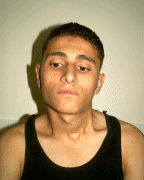
Case report:
A young 18 years age male came with congenital torticollis with the left SCMM tight as a band unabeling him to turn his head to the right with wide spread involvement of the cranium with asymmetry of the skull and brain in the MRI. The face also asymmetric as noticed in the video record. The case was introduced to show the simplicity of procedure and no sophistication in theoretical resolution of his problem. Sectioning of the entire left SCMM muscle attachment to the clavicle , through very small incision with the sheet is very effective and the result is immediate.
Torticollis is fairly common in children with anterior plagiocephaly and may be either ( I ) a consequence of the abnormal orbital structure. giving a vertical strabismus and compensatory torticollis or (2) the cause of or a contributing factor to the anterior plagiocephaly. Torticollis due to abnormality in one sternocleidomastoid muscle is often associated with anterior plagiocephaly. Until the torticollis is treated. it is difficult if not impossible to treat the anterior plagiocephaly or at least to achieve an acceptable cosmetic result. Over half of children with torticollis have vertical strabismus that is related to structural abnormalities of the orbit that cause dysfunction of the superior oblique muscle. For the same reason, some appear to have anterior plagiocephaly .
Roentgenograms show a characteristic appearance, particularly on the anteroposterior views. In advanced cases the cervical spine has structural scoliosis and the mastoid in the ipsilateral side pulled downward. Due to associated plagiocephaly, the upper outer portion of the orbit appears to be elevated. and the lesser wing of the sphenoid is tilted strikingly upward. The upper portion of the nasal septum may tilt toward the affected side. The sagittal and lambdoidal sutures are often malpositioned but are usually patent.